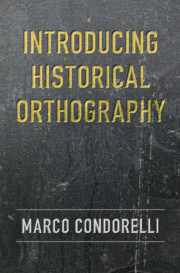Book contents
- Introducing Historical Orthography
- Introducing Historical Orthography
- Copyright page
- Contents
- Figures
- 1 Introduction
- Part I Origins and Sources
- 2 A Short History of Writing
- 3 Witnesses to Historical Writing
- Part II Elements of Orthography
- Part III Analysing Orthography
- Part IV Understanding Orthography
- Bibliography
- Index
- References
3 - Witnesses to Historical Writing
from Part I - Origins and Sources
- Introducing Historical Orthography
- Introducing Historical Orthography
- Copyright page
- Contents
- Figures
- 1 Introduction
- Part I Origins and Sources
- 2 A Short History of Writing
- 3 Witnesses to Historical Writing
- Part II Elements of Orthography
- Part III Analysing Orthography
- Part IV Understanding Orthography
- Bibliography
- Index
- References
Summary
Chapter 3 focuses on some of the most frequently found historical materials and writing instruments which were used for writing. The chapter begins with a discussion of some of the most ancient materials, including stone and metal, as well as some other perishable materials which were in use among the first civilisations around the world. The discussion then moves on to describe papyrus, parchment, vellum, how they were made and what they were generally used for. The chapter also provides an overview of paper as a source of primary evidence, focusing on some of the key steps in the history of papermaking which can provide useful information for a student of orthography. Moving on, the narrative focuses on a short history of typographic styles, while also providing an overview of how to describe and classify type. The sections on paper and typography are informed by some extensive information already existing in the field of bibliography, while also including elements from palaeography.
- Type
- Chapter
- Information
- Introducing Historical Orthography , pp. 39 - 58Publisher: Cambridge University PressPrint publication year: 2022

